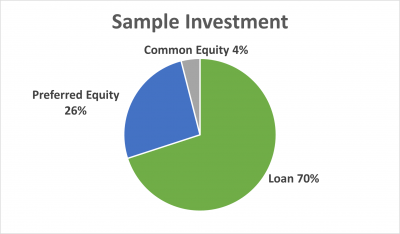How Investors Get Paid
Calculating the return on an investment may involve simple addition, multiplication, and division, but to many, it can seem just as complex as rocket science. When trying to wrap your head around real estate investing, it’s easy to get confused by industry jargon. Let us help clarify three important terms that help explain how real estate investors get paid.
Internal Rate of Return (IRR)
Internal Rate of Return (IRR) is the total rate of return for the project as a whole and determines which projects we move forward with and which ones we disregard. In commercial real estate, IRR is the most common and the most accurate way to project what a certain investment will return.
At Neighborhood Ventures, we pay a 12% IRR to our investors. The most common question we get is “Is that 12% per year? Or is that 12% total?” While the length of time we keep an investment before selling may vary, the answer is that we pay investors a 12% return per year over the life of the project. The property may be held for one year, two years, or three years. And for each of those years, our investors will receive a 12% return annually – but it will be paid out upon the sale of the property.
During the first year, investments are used for renovations, so investors typically do not receive cash distributions in year one. In order for us to pay out the 12%, we must have liquidity (meaning the building has occupied units with rents coming in) or we need to sell the building. During the renovation period, the annual 12% that we owe the investor is being accrued, which means it is owed but hasn’t yet been paid. Prior to the sale of the building, when rents are coming in, investors begin to receive their payouts. Final distributions are made when the building is sold.
Cash on Cash Return
Now that we have covered IRR, we now can move on to Cash on Cash Return. Cash on Cash Return are the funds that are distributed to investors during the life of the project based on property cash flow. In an example of a three-year project, during year one, we don’t expect to pay investors a cash return because that year will be used for renovating the property. During the second year we plan to begin stabilizing the property and hope to begin generating enough revenue to pay a 4% annual cash distribution. Once the property is consistently receiving a sufficient cash-flow, we plan to pay a 6% annual distribution until the sale of the property, at which point, an investor will receive all the accrued interest along with their original investment.
| Year 1 | Year 2 | Year 3 | |
| Cash on Cash Return | 0% | 4% | 6% |
| Accrued Return | 12% | 8% | 6% |
| Total Return | 12% | 12% | 12% |
Currently, investors in two of our projects, Venture on Wilson in Tempe, AZ, and Venture on 66th in Scottsdale, AZ, are receiving 6% annual cash distributions because renovations are complete, and the units are generating rental income.
Preferred Equity
 Preferred equity essentially means that that person gets paid first in terms of any liquidity or any profits that come from the project. At Neighborhood Ventures, our investors receive a preferred return of 12% on their investment, meaning they are the first to get paid.
Preferred equity essentially means that that person gets paid first in terms of any liquidity or any profits that come from the project. At Neighborhood Ventures, our investors receive a preferred return of 12% on their investment, meaning they are the first to get paid.
Neighborhood Ventures is entitled to receive profits only after the preferred equity holders receive their initial investment plus their 12% each year. This ensures that Preferred Equity holders have lower risk since they are paid first.
According to industry publication Financial Samurai, in 2019, crowdfunding investors received an average preferred return of 8%.
Cash Accounts with Neighborhood Ventures
Neighborhood Ventures investors have an option to open a Cash Account that enables them to receive a monthly distribution as opposed to the standard quarterly distribution. Each month, investors with a custodial account receive an email letting them know that a half percent of the expected quarterly distribution is in their account. The account can be used for building and growing a balance which can then be taken out and invested in an upcoming Neighborhood Ventures project. Or at any time, investors may simply transfer those funds into their own bank account.
Sample Investor Returns
| Sample Investment of $5,000 | Distribution | Cash on Cash Return |
| Year 1 | $0 | 0% |
| Year 2 | $200 | 4% |
| Year 3 | $300 | 6% |
| Year 4 |
$6,435 |

About the author
Neighborhood Ventures